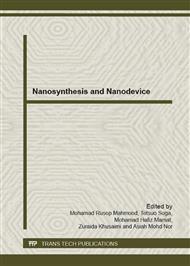p.255
p.260
p.265
p.272
p.277
p.281
p.287
p.294
p.300
The Effects of Inoculum in Fermented Glutinous Rice for Nanotechnology Applications
Abstract:
Carbon nanotubes (CNTs) were unique nanostructured materials composed of single or multiple rolled graphene sheet which usually need expensive sources as a starting material in its preparation. In this paper, new approach of starting material was expected to be commercialized due to its cheaper and renewable properties. Fermented glutinous rice would be optimized before it can be used as starting material in the CNTs preparation. In optimizing the process, a few parameters were considered. One of the important parameters was the amount of inoculums; known as ‘ragi’. This paper showed the effect of inoculums using Fourier Transmission Infrared Spectroscopy (FTIR). The amount was varies depending on percentage of glutinous rice used in the process. The optimum amount of inoculums for nanotechnology application was 3.0% (w/w) of glutinous rice due to the most favorable level of glucose and alcohol after 3 days fermentation. The glucose level decreased whereas alcohol yield was raised when higher inoculums amount were used. The result suggested that sample with inoculums amount of 3.0% (w/w) glutinous rice was the best starting material for nanotechnology application.
Info:
Periodical:
Pages:
277-280
Citation:
Online since:
March 2013
Authors:
Keywords:
Price:
Сopyright:
© 2013 Trans Tech Publications Ltd. All Rights Reserved
Share:
Citation:



